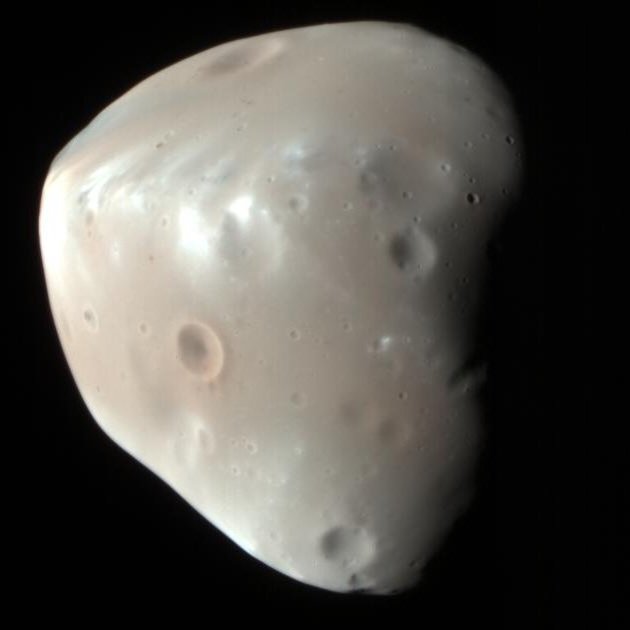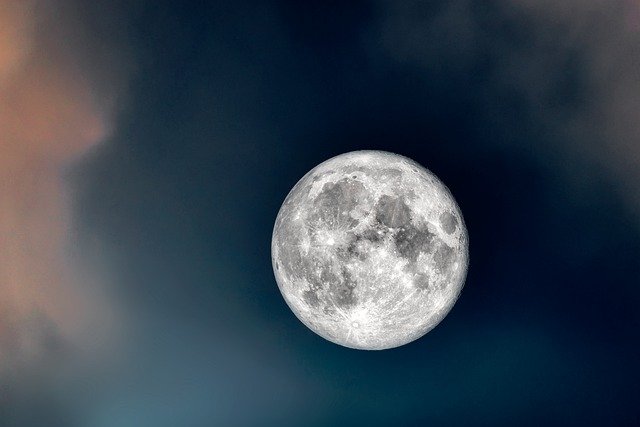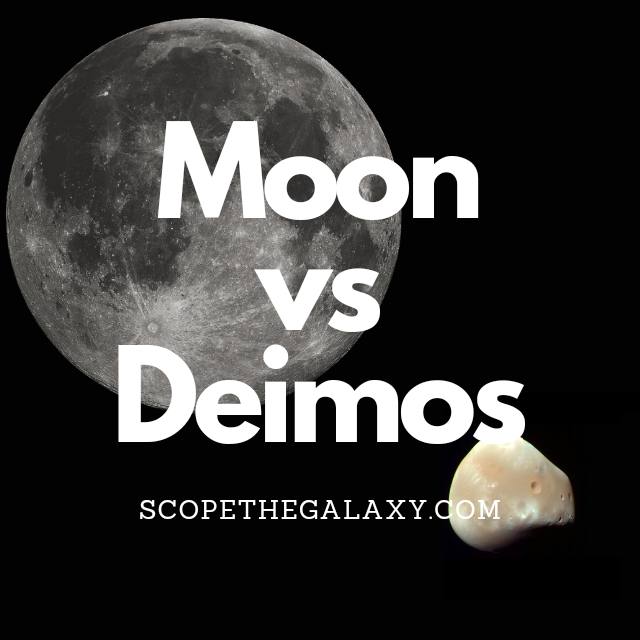*This post may contain affiliate links. This means we may make a commission if you purchase an item using one of our links*
The main differences between Deimos and the Moon are that Deimos is smaller with a diameter of 12.4km while the Moon has a diameter of 3,474.8km, the Moon orbits Earth while Deimos orbits Mars and the Moon is spherical in shape while Deimos is not.
There are numerous other differences between the two so, continue reading for a more detailed look at each of these natural satellites along with their similarities and differences below.
What Is The Moon Deimos?
Table of Contents

Deimos is the smaller and outermost of the two moons of Mars, named after the Greek God of dread and terror (the brother of Phobos). This satellite was also discovered by American astronomer Asaph Hall just five days before Phobos (12th August 1877).
Scientists like Johannes Kepler had put forward theories for the existence of these moons many years before they were discovered. Their calculations were based on the fact that the planets on either side (Earth and Jupiter) possessed one and four moons, respectively.
Still, none were discovered until the 19th century. One of the main reasons for this is that the tiny size of Phobos and Deimos, combined with an exceptionally close orbit to their planet, means that the glare of Mars often obscures our view of them.
Phobos measures just 15 x 12 x 11 km and completes an orbit of Mars once every 30 hours.
This tiny moon is also a heavily cratered landscape shaped by the impact of asteroid collisions over time. However, the material thrown up from these impacts doesn’t appear to have landed back on the moon’s surface as it usually would. This could be because the lack of gravity on Phobos allowed the ejected material into space.
The surface gravity on Deimos is just 0.003 m/s^2 (compared to 9.807 m/s^2 on Earth), which means the average gravitational pull of Deimos is only 0.003 m/s. With only 1/2500th of Earth’s gravity, you would need a tether to walk on this rocky moon, or every step would put you at risk of achieving escape velocity and launching yourself into space.
The composition of Deimos is similar to Phobos, suggesting that it might also be a captured asteroid. Its surface is very dark gray and has an albedo of around 0.07, meaning it reflects just 7% light (about half of the light Earth’s moon can reflect).
What Is The Moon?

The moon is the gray celestial being that orbits our Earth. It is also tidally locked to Earth meaning that we only see one side of it at any time in our sky.
It takes the moon roughly 27 days to complete an orbit around Earth, which it does in an elliptical pattern. The Moon’s axial tilt is very straight at 1.5 degrees. As a result of the tidally locked status along with the effects that Earth has on its general rotational patterns, it takes the Moon roughly 29.5 days to complete a day.
In regards to its temperature, it fluctuates where it can be really hot at 127 degrees Celsius when the Sun is shining on it and to -173 degrees in areas where the Sun does not strike it. It’s core on the other hand is far hotter ranging between 1,327 to 1,427 degrees Celsius.
This is as a result of the lunar entity’s extremely thin to practically non-existent atmosphere, which not only results in these massive temperature shifts but, is also the reason why it has over 100,000 craters on its surface.
Speaking of the Moon’s surface, the entity is mostly made of rocks, iron, magnesium just like most of the other moons and terrestrial based planets in our solar system.
It is among the bigger moons in our solar system with a diameter of 3,474.8km and a mass of 7.35 × 10^22 kg, which actually places it fifth amongst all moons in our solar system and would also make it bigger than the dwarf planet Pluto.
Despite all the advancements in technology, the last time a manned mission was made to the Moon was on the Apollo 17 way back in December 1972 and no further missions have been done since, possibly as result of the political agendas behind the numerous countries vying for opportunities that we don’t know of.
Similarities Between Deimos And The Moon
As both are natural satellites, the Moon and Deimos do share a few similarities, which includes the following:
- Both have a rocky, terrestrial surface.
- Neither have rings surrounding them.
- Both are tidally locked to their planet.
- Both orbit their planet in an elliptical pattern.
- Neither have a magnetic field.
- Neither have tectonic plates
Differences Between Deimos And The Moon
As for the differences between the two, they include the below.
- Deimos orbits Mars whilst the Moon orbits Earth.
- The Moon is a spherical shape while Deimos is not.
- The Moon has a diameter of 3,474.8km whilst Deimos has a diameter of 12.4km.
- Deimos has no atmosphere whilst the Moon has an atmospheric composition that consists of a thin layer with small amounts of helium, argon, and possibly neon, ammonia, methane and carbon dioxide.
- A day on Deimos takes 30 hours whilst a Moon day takes 29.5 days.
- It takes Deimos 30 hours to orbit Mars and around the Sun in 687 days whilst the Moon orbits Earth in 29.5 days and the Sun in 365 days.
- Deimos’ temperature ranges between -4 to -112 degrees Celsius whilst the Moon’s is between 127 degrees and -173 degrees Celsius.
- The Moon’s density is 3.34 g/cm³ whilst Deimos’ density is 1.47 g/cm³.
- The Moon’s mass is 7.35 × 10^22 kg whilst Deimos’ mass is 1.4762 × 10^15 kg.
- Deimos’ gravitational strength is 0.003 m/s² whilst the Moon’s is 1.62 m/s².
- The Moon orbits Earth at an average distance of 384,400 km whilst Deimos is 24,680 km away from Mars
- The Moon has a central core while Deimos does not.
Summary
The Moon and Deimos are both natural satellites that orbit a planet and are terrestrial, low density floating rocks but, there are still numerous differences between the two.
Whether it be in regards to mass, size, orbital periods, distance from their planets, their physical shape and more, so despite the numerous similar features these two share, they are still easy to tell apart due to their distinguishable features.

